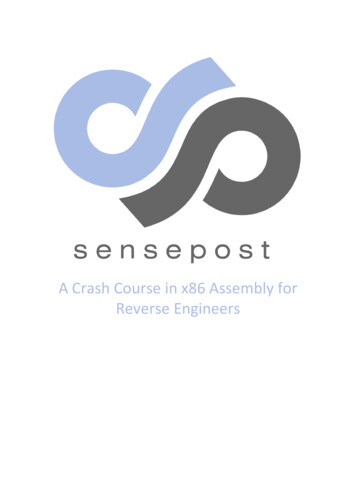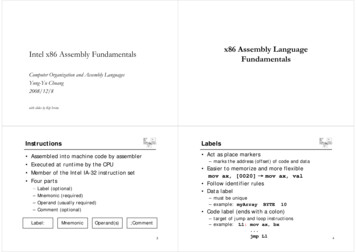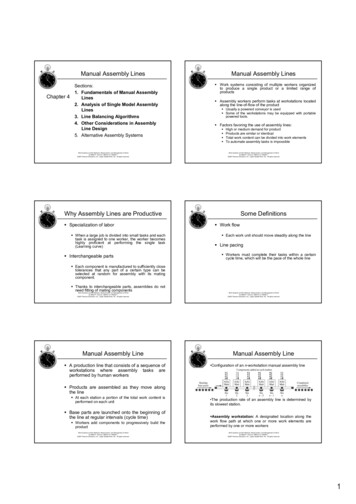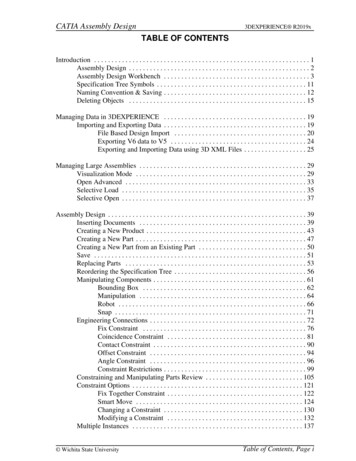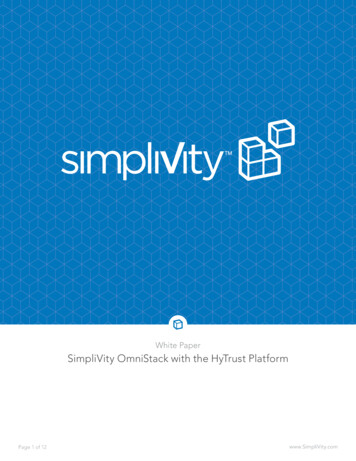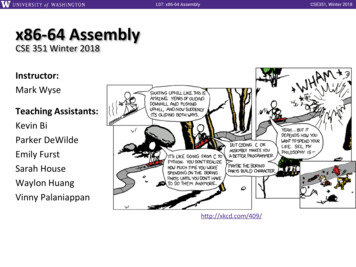
Transcription
L07: x86-64 AssemblyCSE351, Winter 2018x86-64 AssemblyCSE 351 Winter 2018Instructor:Mark WyseTeaching Assistants:Kevin BiParker DeWildeEmily FurstSarah HouseWaylon HuangVinny Palaniappanhttp://xkcd.com/409/
L07: x86-64 AssemblyCSE351, Winter 2018Administrivia Lab 1 due today! Submit bits.c and pointer.c Homework 2 due next Wednesday (1/24) On Integers, Floating Point, and x86-642
L07: x86-64 AssemblyCSE351, Winter 2018Floating point topics Fractional binary numbersIEEE floating-point standardFloating-point operations and roundingFloating-point in CThere are many more details thatwe won’t cover It’s a 58-page standard 3
L07: x86-64 Assembly!!!Floating Point in C C offers two (well, 3) levels of precisionfloatdoublelong double CSE351, Winter 20181.0f1.01.0Lsingle precision (32-bit)double precision (64-bit)(“double double” or quadruple)precision (64-128 bits)#include math.h to get INFINITY and NANconstantsEquality ( ) comparisons between floating pointnumbers are tricky, and often return unexpectedresults, so just avoid them!4
L07: x86-64 AssemblyCSE351, Winter 2018Floating Point Conversions in C !!!Casting between int, float, and double changesthe bit representation int float May be rounded (not enough bits in mantissa: 23)Overflow impossible int or float double Exact conversion (all 32-bit ints representable) long double Depends on word size (32-bit is exact, 64-bit may be rounded) double or float int Truncates fractional part (rounded toward zero)“Not defined” when out of range or NaN: generally sets to Tmin(even if the value is a very big positive)5
L07: x86-64 AssemblyCSE351, Winter 2018Number Representation Really Matters 1991: Patriot missile targeting error clock skew due to conversion from integer to floating point 1996: Ariane 5 rocket exploded ( 1 billion) overflow converting 64-bit floating point to 16-bit integer 2000: Y2K problem limited (decimal) representation: overflow, wrap-around 2038: Unix epoch rollover Unix epoch seconds since 12am, January 1, 1970 signed 32-bit integer representation rolls over to TMin in 2038 Other related bugs: 1982: Vancouver Stock Exchange (truncation instead of rounding)1994: Intel Pentium FDIV (floating point division) HW bug ( 475 million)1997: USS Yorktown “smart” warship stranded: divide by zero1998: Mars Climate Orbiter crashed: unit mismatch ( 193 million)6
L07: x86-64 AssemblyCSE351, Winter 2018RoadmapC:Java:car *c malloc(sizeof(car));c- miles 100;c- gals 17;float mpg get mpg(c);free(c);Car c new Car();c.setMiles(100);c.setGals(17);float mpg c.getMPG();Assemblylanguage:Machinecode:get mpg:pushqmovq.popqret%rbp%rsp, %rbp%rbpMemory & dataIntegers & floatsx86 assemblyProcedures & stacksExecutablesArrays & structsMemory & cachesProcessesVirtual memoryMemory allocationJava vs. 0111000010110000011111101000011111Computersystem:7
L07: x86-64 AssemblyCSE351, Winter 2018Basics of Machine Programming & Architecture What is an ISA (Instruction Set Architecture)?A brief history of Intel processors and architecturesIntro to Assembly and Registers8
L07: x86-64 AssemblyCSE351, Winter 2018TranslationCode TimeCompile TimeUserprogramin CCcompiler.c fileRun TimeAssemblerHardware.exe fileWhat makes programs run fast(er)?9
L07: x86-64 AssemblyCSE351, Winter 2018HW Interface Affects PerformanceSource codeCompilerArchitectureHardwareDifferent applicationsor algorithmsPerform optimizations,generate instructionsInstruction setDifferentimplementationsIntel Pentium 4C LanguageProgramAIntel Core i7GCCx86-64AMD RyzenAMD EpycProgramBIntel XeonClangYourprogramARMv8(AArch64/A64)ARM Cortex-A53Apple A710
L07: x86-64 AssemblyCSE351, Winter 2018Definitions Architecture (ISA): The parts of a processor designthat one needs to understand to write assembly code “What is directly visible to software” Microarchitecture: Implementation of thearchitecture CSE/EE 469, 470 Are the following part of the architecture? Number of registers? How about CPU frequency? Cache size? Memory size?11
L07: x86-64 AssemblyCSE351, Winter 2018Instruction Set Architectures The ISA defines: The system’s state (e.g. registers, memory, programcounter) The instructions the CPU can execute The effect that each of these instructions will have on thesystem stateCPUPCMemoryRegisters12
L07: x86-64 AssemblyCSE351, Winter 2018Instruction Set Philosophies Complex Instruction Set Computing (CISC): Add moreand more elaborate and specialized instructions asneeded Lots of tools for programmers to use, but hardware must beable to handle all instructions x86-64 is CISC, but only a small subset of instructionsencountered with Linux programs Reduced Instruction Set Computing (RISC): Keepinstruction set small and regular Easier to build fast hardware Let software do the complicated operations by composingsimpler ones13
L07: x86-64 AssemblyCSE351, Winter 2018General ISA Design Decisions Instructions What instructions are available? What do they do? How are they encoded? Registers How many registers are there? How wide are they? Memory How do you specify a memory location?14
L07: x86-64 AssemblyCSE351, Winter 2018Mainstream ISAsMacbooks & PCs(Core i3, i5, i7, M)x86-64 Instruction SetSmartphone-like devices(iPhone, iPad, Raspberry Pi)ARM Instruction SetDigital home & networkingequipment(Blu-ray, PlayStation 2)MIPS Instruction Set15
L07: x86-64 AssemblyCSE351, Winter 2018Intel/AMD x86 Evolution: K16-3319933.2M60199922M500-2333First 16-bit Intel processor. Basis for IBM PC & DOS1 MB address space3861985First 32-bit Intel processor, referred to as IA32Added “flat addressing,” capable of running UnixPentium (P5)First superscalar IA32Athlon (K7)First desktop processor with 1 GHz clock (at roughly same time as Pentium III)Athlon 64 (K8)2003106M1600-3200125M2800-3800First x86-64 processor architecturePentium 4E2004First 64-bit Intel x86 processor16
L07: x86-64 AssemblyCSE351, Winter 2018Intel/AMD x86 Evolution: MilestonesNameDateTransistorsMHzCore 00First multi-core Intel ProcessorCore i7Four coresAMD Phenom (K10)First “true” quad core, with all cores on same silicon dieCore i7 (Coffee Lake)2017?2800-4700Ryzen 7 (Zen)20174.8B3000-420017
L07: x86-64 AssemblyCSE351, Winter 2018Technology gy-quarterly/2016-03-12/after-moores-law18
L07: x86-64 AssemblyCSE351, Winter 2018Transition to 64-bit Intel attempted radical shift from IA32 to IA64 (2001) Completely new architecture (Itanium) Execute IA32 code only as legacy Performance disappointing AMD solution: “AMD64” (2003) x86-64, evolutionary step from IA32 Intel pursued IA64 Couldn’t admit its mistake with Itanium Intel announces “EM64T” extension to IA32 (2004) Extended Memory 64-bit Technology Nearly identical to AMD64!19
L07: x86-64 AssemblyCSE351, Winter 2018Assembly Programmer’s ViewCPUPCAddressesRegistersDataConditionCodes InstructionsMemory Code Data StackProgrammer-visible state PC: the Program Counter (%rip in x86-64) Address of next instruction Named registersTogether in “register file” Heavily used program data Condition codesStore status information about most recentarithmetic operation Used for conditional branching Memory Byte-addressable array Code and user data Includes the Stack (forsupporting procedures)20
L07: x86-64 AssemblyCSE351, Winter 2018Three Basic Kinds of Instructions1) Transfer data between memory and register Load data from memory into register %reg Mem[address] Store register data into memory Mem[address] %regRemember: Memoryis indexed just like anarray of bytes!2) Perform arithmetic operation on register or memorydata c a b;z x y;i h & g;3) Control flow: what instruction to execute next Unconditional jumps to/from procedures Conditional branches21
L07: x86-64 AssemblyCSE351, Winter 2018x86-64 Assembly “Data Types” Integral data of 1, 2, 4, or 8 bytes Data values Addresses (untyped pointers) Floating point data of 4, 8, 10 or 2x8 or 4x4 or 8x2 Different registers for those (e.g. %xmm1, %ymm2) Come from extensions to x86 (SSE, AVX, ) Not coveredIn 351No aggregate types such as arrays or structures Just contiguously allocated bytes in memory Two common syntaxes “AT&T”: used by our course, slides, textbook, gnu tools, “Intel”: used by Intel documentation, Intel tools, Must know which you’re reading22
L07: x86-64 AssemblyCSE351, Winter 2018What is a Register? A location in the CPU that stores a small amount ofdata, which can be accessed very quickly (once everyclock cycle) Registers have names, not addresses In assembly, they start with % (e.g. %rsi) Registers are at the heart of assembly programming They are a precious commodity in all architectures, butespecially x8623
L07: x86-64 AssemblyCSE351, Winter 2018x86-64 Integer Registers – 64 bits r14%r15%r14d%r9d%r10d%r12d%r13d%r15d Can reference low-order 4 bytes (also low-order 2 & 1 bytes)24
L07: x86-64 AssemblyCSE351, Winter 2018general purposeSome History: IA32 Registers – 32 bits x%dx%dh%dldata%ebx%bx%bh%blbase%esi%sisource index%edi%didestination index%esp%spstack pointer%ebp%bpbase pointer16-bit virtual registers(backwards compatibility)Name Origin(mostly obsolete)25
L07: x86-64 AssemblyMemory Addressesvs. Registersvs. 0x7FFFD024C3DC Bigvs.SlowDynamic Can “grow” as neededSmall(16 x 8 B) 128 Bvs. 50-100 ns Names%rdi 8 GB CSE351, Winter 2018Fastsub-nanosecond timescalevs.Staticfixed number in hardwarewhile program runs26
L07: x86-64 AssemblyCSE351, Winter 2018Operand types Immediate: Constant integer data Examples: 0x400, -533 Like C literal, but prefixed with ‘ ’ Encoded with 1, 2, 4, or 8 bytesdepending on the instruction Register: 1 of 16 integer registers Examples: %rax, %r13 But %rsp reserved for special use Others have special uses for particularinstructions Memory: Consecutive bytes of memoryat a computed address%rax%rcx%rdx%rbx%rsi%rdi%rsp%rbp%rN Simplest example: (%rax) Various other “address modes”27
L07: x86-64 AssemblyCSE351, Winter 2018Summary x86-64 is a complex instruction set computing (CISC)architectureRegisters are named locations in the CPU for holdingand manipulating data x86-64 uses 16 64-bit wide registers Assembly operands include immediates, registers,and data at specified memory locations28
L07: x86-64 AssemblyCSE351, Winter 2018Floating Point Summary Floats also suffer from the fixed number of bitsavailable to represent them Can get overflow/underflow “Gaps” produced in representable numbers means we canlose precision, unlike ints Some “simple fractions” have no exact representation (e.g. 0.2)“Every operation gets a slightly wrong result”Floating point arithmetic not associative ordistributive Mathematically equivalent ways of writing an expressionmay compute different results Never test floating point values for equality!Careful when converting between ints and floats!29
L07: x86-64 AssemblyCSE351, Winter 2018Floating Point Summary Converting between integral and floating point datatypes does change the bits Floating point rounding is a HUGE issue! Limited mantissa bits cause inaccurate representationsFloating point arithmetic is NOT associative or distributive30
L07: x86-64 Assembly CSE351, Winter 2018 Floating Point Conversions in C Casting between int, float, and doublechanges the bit representation int float May be rounded (not enough bits in mantissa: 23) Overflow impossible intor float double Exact conversion (all 32-bit ints representable) long double Depe
